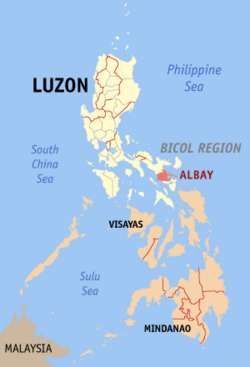Albay
| Albay | |||
|---|---|---|---|
| Province | |||
| Province of Albay | |||

Albay Provincial Capitol in Legazpi
|
|||
|
|||
 Location in the Philippines |
|||
| Coordinates: 13°14′N 123°38′E / 13.23°N 123.63°ECoordinates: 13°14′N 123°38′E / 13.23°N 123.63°E | |||
| Country | Philippines | ||
| Region | Bicol Region (Region V) | ||
| Founded | April 3, 1574 | ||
| Capital | Legazpi | ||
| Government | |||
| • Type | Sangguniang Panlalawigan | ||
| • Governor | Francis Bichara (Nacionalista) | ||
| • Vice Governor | Harold Imperial (Liberal) | ||
| Area | |||
| • Total | 2,575.77 km2 (994.51 sq mi) | ||
| Area rank | 53rd out of 81 | ||
| Population (2015 census) | |||
| • Total | 1,314,826 | ||
| • Rank | 20th out of 81 | ||
| • Density | 510/km2 (1,300/sq mi) | ||
| • Density rank | 12th out of 81 | ||
| Divisions | |||
| • Independent cities | 0 | ||
| • Component cities | |||
| • Municipalities | |||
| • Barangays | 720 | ||
| • Districts | 1st to 3rd districts of Albay | ||
| Time zone | PHT (UTC+8) | ||
| ZIP Code | 4500–4517 | ||
| IDD : area code | +63 (0)52 | ||
| ISO 3166 code | PH-ALB | ||
| Spoken languages | |||
| Website | www |
||
Albay (Central Bikol: Probinsya kan Albay; Filipino: Lalawigan ng Albay) is a province located in the Bicol Region in southeastern Luzon of the Philippines. Its capital is the city of Legazpi, the regional administrative center of the whole Bicol Region, which is located in the southern foothill of Mayon Volcano, the symbol most associated with the province. This perfectly symmetrical active stratovolcano forms a magnificent, scenic backdrop to the city of Legazpi and is visible throughout the municipalities and cities of Albay including the surrounding provinces.
The province was added to the UNESCO World Network of Biosphere Reserves in March 2016.
Long before the Spaniards arrived, Albay had a thriving civilization. Formerly called Ibat, and then Libog, Albay was once ruled by Gat Ibal, an old chief who also founded the old barangay of Sawangan, now part of the city of Legazpi.
In July 1569, Luis Enriquez de Guzman, a member of the expedition led by Maestro de Campo Mateo de Saz and Captain Martin de Goiti, led a group which crossed from Burias and Ticao islands and landed on a coastal settlement called Ibalon in what is now the province of Sorsogon. From this point another expedition was sent to explore the interior and founded the town of Camalig.
...
Wikipedia


